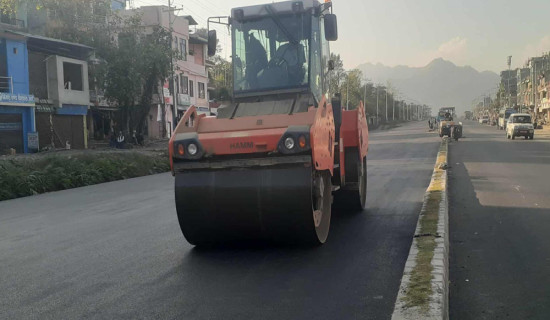- Thursday, 13 November 2025
LDCs Should Not Suffer Climate Impacts
The effects of global warming on our planet are a slow, silent killer, posing a significant threat to all life on Earth. Least Developed Countries (LDCs), like Nepal, are among those most affected by the high levels of carbon emissions generated by wealthier, industrialised nations.
Various initiatives, led by the United Nations and other global bodies, aim to limit global warming to 1.5 degrees Celsius. The annual Conference of the Parties (COP), organised by the UN, offers leaders a platform to evaluate their progress—or lack thereof—on climate-related commitments. The most recent COP took place from November 11–12, 2024, in Azerbaijan, where President Ram Chandra Poudel represented Nepal alongside a national delegation. Despite such efforts, meeting key climate goals remains challenging. The Paris Agreement on climate change, now a decade old, has seen progress with new net-zero pledges and innovative technology, yet global temperatures continue to rise.
Alarming trend
According to the National Centres for Environmental Information’s Monthly Global Climate Report for January 2024, the average global land and ocean surface temperature for January was 1.27°C above the 20th-century average of 12.0°C, marking the warmest January in the 175-year record. This alarming trend has severe consequences for the world's 45 LDCs, which, despite being the lowest carbon emitters, bear a disproportionate share of the climate crisis’s impacts. The World Bank reports that over the past decade, these countries have faced nearly eight times as many natural disasters as three decades ago, leading to a threefold increase in economic damages.
Nepal has witnessed this reality firsthand, with recent heavy rains causing floods, landslides, and widespread destruction of lives, livestock, and infrastructure. This devastation has set back Nepal’s development progress, as the damage to roads and bridges has made land travel extremely difficult. As a landlocked country, Nepal faces additional challenges in recovery. Neighbouring South Asian countries, including Bangladesh, Pakistan, India, and Afghanistan, are similarly impacted. These nations share the Himalayas and various mountain ranges and river systems, so climate-induced disasters in one country often have ripple effects in others.
Changing weather patterns, prolonged droughts, flooding, crop failures, deforestation, and rising sea levels heavily affect LDCs, which largely depend on agriculture. Climate change threatens farming productivity, worsening the outlook for millions living in these vulnerable economies. Even as I write, policymakers are meeting in Azerbaijan for COP 29. They must urgently prioritise the financial, technical, and capacity-building support that LDCs require to confront the climate crisis. While countries like Nepal are bearing the consequences of wealthy nations’ carbon emissions, we have also made substantial contributions to global sustainability. Over the last decade, Nepal has increased its forest cover through successful reforestation projects, which in turn enhances global oxygen levels—a feat deserving of recognition.
Unfortunately, with global public debt nearing $100 trillion, some industrialised nations may reconsider their climate investments, from emission reductions to environmental protections.
Leadership from the private sector is essential for driving meaningful action, both through voluntary measures and by pressuring governments for policy reform. While summits like the one in Azerbaijan hope to inspire collaboration towards a healthier, cooler planet, critics argue that such goals remain a far elusion.
The ongoing COP 29 conference is being referred to as the "Conference for Climate Financing" due to the critical focus on financial commitments from wealthy, industrialised nations. These financial contributions are vital to the global response to climate change, as they support LDCs and other vulnerable regions in mitigating and adapting to climate impacts. At COP 29, developing nations are pressing for increased funding to address the disproportionate effects of climate change they face, despite contributing the least to global carbon emissions. Effective climate financing could determine how successfully the world manages the climate crisis going forward.
The voices of LDCs often fail to make a significant impact, despite these nations suffering the most due to the actions of others. With the re-election of Donald Trump as President of the United States, there is concern about America’s stance on climate change. Trump, a staunch advocate for industrialisation, has historically downplayed the severity of climate issues. Given the current global conflicts, which fuel both politics and economies through the arms industry, addressing climate change remains uncertain for many observers.
Warmest year
Nearly 200 countries are attending COP 29 in Azerbaijan. Media coverage, including that by the BBC, indicates that many issues remain unresolved, and discussions are ongoing about the summit’s formal agenda. Thousands of politicians, negotiators, scientists, and activists are now in Azerbaijan, where John Podesta, representing U.S. President Joe Biden, has promised that the United States will continue to support climate action, despite Trump’s re-election.
The UN’s Meteorological Organisation recently reported that 2024 is on track to be the warmest year on record, with global temperatures from January to September approximately 1.54°C higher than those of the late 19th century. Behind closed doors, countries are debating whether to continue moving away from fossil fuels, as agreed upon in the last COP, or to focus on financial discussions. Nations heavily dependent on fossil fuels appear to be pushing for discussions about cash, rather than committing to phasing out fossil energy sources.
It is crucial that all COP 29 participants take climate change seriously and develop mechanisms to hold high-emission countries accountable. Nepal, which has endured the brunt of global warming’s effects but increased its forest area and oxygen output, should receive compensation for the actions of others that impact our fragile Himalayan environment.
(Namrata Sharma is a senior journalist and women’s rights advocate. She can be reached at namrata1964@yahoo.com, Twitter: @NamrataSharmaP)















-original-thumb.jpg)
